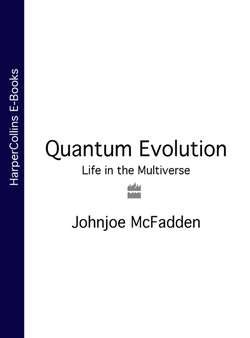Читать книгу Quantum Evolution: Life in the Multiverse - Johnjoe McFadden - Страница 14
LIFE WITHOUT AIR
ОглавлениеLiving and breathing are, for humans, inextricably linked. We talk of ‘the breath of life’. Animals need oxygen to live. Yet there are many living organisms for which the breath of life is poisonous. Microbes, known as anaerobes, do not breathe air: indeed many are instantly killed on exposure to oxygen. This sensitivity makes anaerobes difficult to study and so their prevalence has not been appreciated until fairly recently. It may come as a surprise to you to know that more than eighty per cent of your faeces is made up of anaerobic bacteria. Very little air penetrates our lower bowels, making it an ideal environment for the proliferation of these microbes. The vast majority of these gut bacteria are entirely harmless colonizers of our intestinal tract or even beneficial; but they may occasionally cause problems (mostly abscesses and ulcers) particularly if introduced into the rest of the body by wounds or surgery. Anaerobic microbes are also widespread in the environment. They are found in the soil and in fresh and seawater, particularly in the air-depleted sediments at the bottom of lakes, rivers, seas and oceans.
So how do anaerobes live without oxygen? It’s easy – it’s living with oxygen that is the difficult feat. Toxic to all living organisms, oxygen is highly reactive – reacting with tissue to generate even more unpleasant chemicals such as hydrogen peroxide (used to bleach hair) and molecules known as free radicals. Air-breathing organisms have an armoury of protective enzymes to remove and destroy these toxic chemicals. Strict anaerobes lack these protective enzymes and are killed by oxygen.
So why do we go to so much trouble to breathe air when one of its chief components, oxygen, is so toxic? We use it to burn our food in the process known as respiration. Chapter 5 will examine respiration more closely, but briefly: electrons are harvested from our food and rolled down a kind of energy cascade to oxygen. The difference in energy (high-energy electrons from food to low-energy electrons in oxygen) is captured, providing energy for the cell. Oxygen-based respiration is a very efficient means of extracting maximum energy from food and has thus superseded the anaerobic metabolism in most higher organisms.
Some anaerobes burn their food in respiration, but not with oxygen. Many minerals (such as sulfate or nitrate) serve as low-energy electron dumps for their respiratory cascade. You may well have noticed that the sand alongside estuary waters is often black and smelly. The bad smell is hydrogen sulfide and the blackness is due to the presence of iron sulfide, both products of anaerobic bacteria’s respiration in these estuarine waters. In fact, a wide range of minerals can be utilized by bacteria for respiration; some bacteria can even breathe iron.
Still other anaerobes do not actually respire at all but derive their energy from chopping up their food molecules into small pieces, usually into simple acids or alcohol, in a process known as fermentation. Fermented foods and beverages like wine, beer, sauerkraut, cheese and even coffee, depend upon the actions of these busy microbes. Anaerobes are of enormous ecological importance since they are often responsible for the final decay of organic matter. A giant compost heap would have long since enveloped the whole planet were it not for these bacteria. Cows and other ruminants have learned to harness the powers of these microbes. Their stomachs house an internal compost heap of plant material decomposing through the activity of billions of fermentative bacteria. One of the by-products of their fermentation is the greenhouse gas, methane. The huge quantities of the gas flatulently emitted by (the bacteria inside) domesticated ruminants is thought to contribute signifycantly to the greenhouse effect.
Far from being the breath of life, life carries on very well in oxygen’s complete absence. This must of course be so, since (as covered further in Chapter 4) life emerged on this planet in an atmosphere completely devoid of oxygen. It was only after photosynthetic plants and microbes began to pour oxygen into the earth’s atmosphere that aerobic life became possible on Earth.
